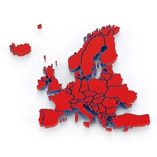Expanding to other European countries requires more than patience and proper language translations
 Chase Paymentech Europe has announced results from a national survey exploring the challenges faced by UK firms in ‘Customer Not Present’ (CNP) payments. Western European online retail sales are projected to grow 11 percent to reach £153 billion by 2014. On a regional level, several key European countries have seen record growth above the UK’s growth of 160 percent over the past few years: examples include Spain at 199 percent and both France and Italy at 181 percent. Martijn Werdler, Commercial Director at Docdata Payments takes a look at the impact on payments for cross border e-commerce.
Chase Paymentech Europe has announced results from a national survey exploring the challenges faced by UK firms in ‘Customer Not Present’ (CNP) payments. Western European online retail sales are projected to grow 11 percent to reach £153 billion by 2014. On a regional level, several key European countries have seen record growth above the UK’s growth of 160 percent over the past few years: examples include Spain at 199 percent and both France and Italy at 181 percent. Martijn Werdler, Commercial Director at Docdata Payments takes a look at the impact on payments for cross border e-commerce.
The rapid growth of eCommerce sales triggers a lot of web shops aiming to develop new revenue streams via international expansion into lucrative European markets. This, in turn, has lead to organisations looking to cross-border sales to build or increase their European customer base, however when questioned 79 percent of finance directors felt that their payment systems were not ready.
Cross-border sales require merchants to present and settle in a wide number of Methods of Payments (MOPs). These include common options such as Visa, MasterCard, Maestro, American Express and Direct Debit but also regional offerings such as ELV in Germany and iDEAL in the Netherlands. Next to the payment methods, the consumer behaviour is also very important
To give you an example of the complexity of the international landscape we highlighted some Local payment methods:
In Germany the payment method ‘Verkauf auf Rechnung / Rechnungkauf’ is used for approximately 50% of all payments by German Retailers. Next to the needed Giropay and Sofortüberweisung. A trend in Germany is that consumer preference for offline payment methods has decreased over the years (almost 12% compared to 2007) and that the number of payment with online methods, such as credit card and Sofortüberweisung has increased. The most prominent growth is shown by Paypal
In the Netherlands, iDEAL ranks highest in the top of the most popular online payment systems, with over 75% of online shoppers preferring this payment method to any other option. Similar iDEAL developments are seen in Austria. Italy and France, in contrary, are pure credit card payment focussed combined with an increase of Paypal paments in the last year.
In Belgium next to Mr. Cash, eMaestro has rapidly grown due to the acquisition of different local payment options by MasterCard.
According the recent Pago report, consumers in the UK use credit card payment for over 90% of their online purchases. This payment method is offered by 96% of the merchants in 2010. Maestro, the leading international debit payment method, which is gaining ground in e-commerce in comparison to credit cards, is the only other payment method which seems acceptable to British consumers, with a share of 5.10% in 2009 and a share of 10% in 2010.
PayPal is accepted by 32% of the merchants. Paypal recently announced that there were more than 15 million account holders in the UK, which represent a third of the adult population and half of all UK Internet shoppers. Google Checkout is accepted by 9% of the merchants, 31% accepts bank transfers.
This short overview emphasizes that, without the proper payment systems in place, organisations are often required to work with multiple acquirers to trade in a range of markets or currencies next to the Euro. For example Poland, Ukraine and Turkey are very fast growing eCommerce countries with other main accepted currencies.
Next to accepting different local payment methods, understanding online payment solutions requires a thorough understanding of the transaction context. Human behaviour is continuously changing giving way for new ways of transacting. Social networks, mobileapps, growing businesses and supply chains integration are main topics which have to be monitored constantly on their added value applicable to their specific branche. E-invoicing, e-payments and e-identity are the new frontiers where webshops can create significantly increase of conversion/turn over.
Customers in all parts of the world support products and services based on convenience and personal buying preference. If you are an online retailer expanding into other countries, it is best to choose the payment service provider that has experience and a regional network of banking relationships. This means a payment service provider offering more than just technology. A partner that supports the proper payment alternatives, global currencies and has the banking relationships needed to succeed!
Good luck and if you want to know more about choosing the right local payment methods, you can apply for an update on this blog. Next time, I will add an updated overview with more countries and their local payment methods and aspects. There’s is more to internationalization than translations and patience only.






Leave a Reply
Want to join the discussion?Feel free to contribute!